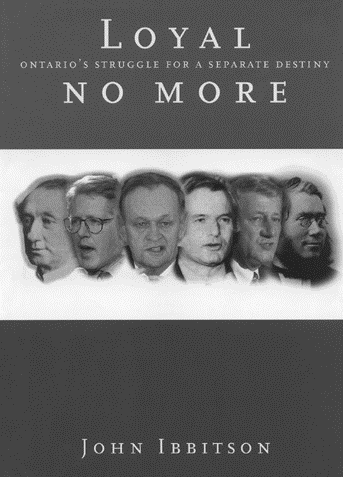
This is another book about the unstoppable force of globalization. John Ibbitson, political columnist for the Globe and Mail and chronicler of Mike Harris’s Common Sense Revolution argues that Canada is disintegrating. As a result of free trade, the country’s transcontinental economy is being reoriented along north-south lines. This shift effectively removes the economic imperatives that drove Confederation and the interregional bargaining that sustained it. In an era of free trade, national unity and regional economic self-interest increasingly conflict.
But this grim news plays second fiddle to Ibbitson’s main argument, which is that Ontario—not the alienated West nor nationalist Quebec—will be Confederation’s enfant terrible in the years to come. Post-war prime ministers could always rely on Ontario to support Ottawa’s management of the federation. But no more: the federal government, still intent on transferring wealth generated in Ontario to the poorer regions of the country, will find itself in “perpetual conflict” with an increasingly assertive Queen’s Park. “A federation so constructed cannot endure,” Ibbitson warns.
But he also argues that present-day Ontario’s continuing troubles with Ottawa and growing affinity with decentralist governments in Quebec and Alberta are evidence that the province is now “engaged in a struggle to return to its former self.” He reminds us that, for decades after 1867, Ontario played the lead role in the fight to limit federal power. Premier Oliver Mowat regularly outwitted John A. Macdonald and, together with Honoré Mercier of Quebec, formed an Ontario-Quebec axis in defence of provincial rights. Ibbitson goes so far as to refer to Premier Mike Harris as “Mowat’s heir.”
Ibbitson has produced a well-written, entertaining book that challenges many popular myths about middle-of-the-road Ontario and its place in the federation. The book’s first chapters in particular are very strong. He recalls the thinking of the province’s 19th-century political leaders as they contemplated Confederation. As other Canadians have always suspected, Ontario’s political class saw Confederation as the tool that would allow it to realize its imperialist ambition of dominating the top half of North America. The province’s leaders behaved accordingly, refusing to defer to Ottawa whenever it argued that the national interest conflicted with the provincial one.
But the experience of two world wars and the Great Depression changed everything. Ibbitson cheekily suggests that “the coming carnage in Europe would be the best news the federalists ever had,” since the wars justified a massive expansion of federal government activity. Suddenly, Ontario supported centralization. And its premiers continued this support after 1945, as Canada established its welfare state.
But as he tries to account for this change, Ibbitson’s argument weakens. The clearest example is his discussion of the relationship between Bill Davis and Pierre Trudeau. In Ibbitson’s view, Davis’s support for Trudeau’s centralism was based on economic self-interest: Ontario needed protection from the rising world price of oil. The only way to get it was to support Ottawa’s assault on provincial rights, be it via the National Energy Policy or the patriation of the constitution. In exchange for Alberta’s cheap oil, Davis became Trudeau’s “loyal and unquestioning ally.”
This is hardly a satisfying explanation for Davis’s brand of Ottawa-friendly Toryism. Ibbitson concedes in passing that Davis and Trudeau also shared a vision of a country whose unity was based on bilingualism, a concern for Quebec’s place in Canada, industrial policy and regional development—all underpinned by a strong federal government. But his argument is undermined by his unwillingness to take this vision seriously, and to ask whether it might be a deep-rooted and enduring facet of Ontario’s political culture, not just the fancy of two statist politicians.
The book picks up strength again as it nears its conclusion. Ibbitson describes how recent Ontario governments—beginning with Bob Rae’s— became increasingly resentful of federal transfer programs that redistribute wealth from Ontario to the “have-not” provinces. Rae’s anxiety was heightened by the recession of the early 1990s. A province unable to meet the needs of its citizens found itself still subsidizing other regions of the country. By contrast, Mike Harris’s antipathy to federal policy is based on a desire to protect the strength and competitiveness of the Ontario economy.
But there is much more to Ontario’s current obstreperousness than Harris’s ideological aversion to big government. Echoing Tom Courchene, Ibbitson argues that free trade has changed the rules of the game. Time was when wealth transferred from Ontario was offset by cheap natural resources from the other provinces, and a captive Canadian market for Ontario products. Under free trade, however, Ontario no longer depends on buyers and sellers in the rest of Canada. Like all provinces, Ontario’s biggest customer is the US, and for this reason it is less and less interested in subsidizing less prosperous provinces.
Thus, as a result of free trade, “the economic bonds between Ontario and the rest of the country have weakened dramatically.” What’s more, free trade has emasculated the federal government: Ottawa-led nation-building policies are a thing of the past. Much of what the federal government once enjoyed doing—shaping a national economy by means of tariffs, regulations on investment, and subsidies to industry—is now either prohibited by free trade agreements, or simply anathema ideologically. The federal government’s remaining areas of competence are “meager indeed,” and it has become “essentially an agent of redistribution.” This only exacerbates tensions within the federation, since the federal programs that remain—such as employment insurance and equalization—are precisely those that “infringe on Ontario’s self-interest,” because the province pays in more than it receives.
Ibbitson therefore concludes that free trade has broken the bonds of solidarity among the provinces and placed the very relevance of the federal government in question. “The federation’s reason for being,” he writes, “is gradually dissolving.” In fact, he contends that the country is already halfway towards a “true confederation of autonomous regions” (an argument that would no doubt please Bernard Landry, who is currently broadcasting a vision of Canada reconstituted as an EU-style confederation of sovereign units). In an era of economic globalization, such radical decentralization is Canada’s inevitable fate.
These are all important points, and Ibbitson presents them cogently. He is right to insist that economic globalization and the north-south flow of trade place a strain on the ties of national unity in Canada that will test the country’s resolve to survive. All the same, his account is one-sided.
Ibbitson’s assessment of Ontario’s personality is based on his reading of the actions of its most recent governments, and not the entrenched opinions of its citizens. If Ontario really is estranged from Confederation and increasingly resentful of the federal government’s appropriation of the province’s wealth in the name of national standards, why is it that Ontarians are among the federal government’s most enthusiastic supporters? Ontarians are far more likely than Quebecers or Albertans to say the federal government, not the provinces, should take the lead in reforming health care, so as to ensure a national approach. Ontarians are the least likely of Canadians to say that the federal government has too much power, and the most likely to say their provincial government has too much power. When asked which level of government they trust more to protect the programs they care about, they are the least likely to say their provincial government, and most likely to say either the federal government, or both the federal and provincial governments equally. (These are some of the findings of Portraits of Canada 2000, a survey undertaken by the Centre for Research and Information on Canada. A report on the survey is available on the website of the Council for Canadian Unity, at https://www.ccu-cuc.ca/. The survey will be repeated this autumn.)
This brings us to the most telling of Ibbitson’s omissions: he does not explain why, throughout the last decade, Ontario voters have been the strongest supporters of the Chrétien Liberals. Fifty-one per cent of Ontarians voted Liberal in the last election, compared to just 35 per cent of voters outside the province. Meanwhile, the party that rejects the federal “tax and redistribute” policies that Ibbitson argues Ontario now questions—namely, the Canadian Alliance— failed for a third time to break through in the province. Some commentators argue this failure was due to Stockwell Day’s “social conservatism,” but it may well be that doubts about the party’s commitment to instruments of national unity, including bilingualism, regional development, and the promotion of national standards, also played a role.
Ibbitson’s reading of Ontario’s political culture is too narrow. Above all, he argues, Ontarians value success, growth and prosperity. He ignores any serious consideration of their political values or of the attachment they have to a pan-Canadian political community—an attachment that may defy a narrow explanation based on economic self-interest. This is the real hole in his argument. Indeed, if one is to follow his logic, it would be difficult to explain what holds Ontario together, since its own regions are arguably as estranged from the Golden Triangle, and as dependent on redistribution, as are Winnipeg and Montreal. Ibbitson’s reluctance to wrestle seriously with the question of political attachments is unfortunate, for one of the most important questions raised by economic globalization is whether it is necessarily destabilizing to all civic associations that rest on something other than the bonds of commerce. Whether or not, in Ontario’s case, attachments to political values and national community can compensate for the decentralizing influence of free trade is an open question. Unfortunately, it is a question that Ibbitson does not deem worth asking.
Photo: Shutterstock








